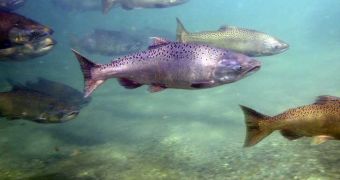News from the state of California in the US says that, courtesy of the severe drought that has hit the region, high officials might be left with no choice except give the thumbs up to plans to transport some 30 million young Chinook salmon to the Pacific Ocean by truck.
Information shared with the public says that transporting this many salmon to the Pacific Ocean by truck is intended to boost the fish's survival chances.
Thus, it would appear that, since the ongoing drought has caused the Sacramento River to become greatly reduced, the chances that hatchery-raised salmon will be able to complete their migration on their own are very limited, chiefly due to low water levels and high temperatures.
According to Think Progress, the state of California should start helping hatchery-raised salmon make it all the way to the Pacific Ocean sometime later this month, provided that rain does not soon fall in the region.
Interestingly enough, it would appear that California is no stranger to transporting salmon to the ocean by truck. However, the number of fish that will get to travel in this fairly odd manner this year is three times greater than usual.
Commenting on the decision to transport salmon to the Pacific Ocean by truck, Dan Castleberry with the California Fish and Wildlife Service stated as follows:
“It is important to recognize two things: first, our decision to adapt fast to drought and truck fish this year should not be used to argue against long-term reform of our hatcheries,”
Furthermore, “Second, the state and federal agencies care greatly about this state’s salmon and the fishing industry. We need to take these adaptive approaches given the severity of this drought.”
The 30 million salmon expected to be carried to the Pacific Ocean by truck will ride in climate controlled, water-filled 18-wheelers, and are expected to reach their hatcheries in San Pablo Bay in about three hours.
Once there, they will be released in netter pens, and will only be allowed to go their own way once they adapt to the new water temperature and salinity, and the new light conditions.
By the looks of it, the state will need a total of 6 trucks to successfully complete this project. It is estimated that the cost of the gas that will be needed to transport the fish will amount to over $100,000 (€71,846).
The vehicles that will be used will be able to carry about 130,000 fish at a time, and will likely complete daily journeys starting the end of March until the middle of June.

 14 DAY TRIAL //
14 DAY TRIAL //